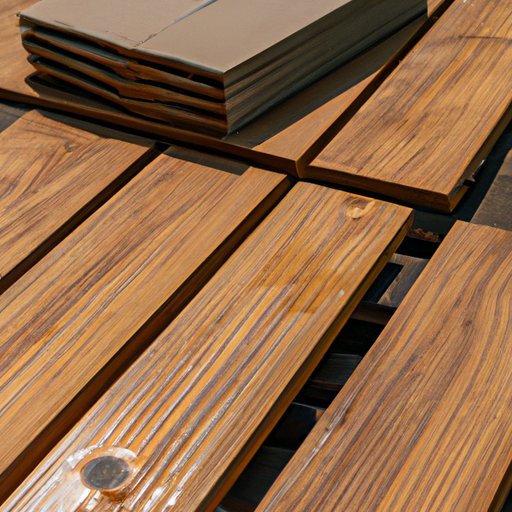
I. Introduction
Building a deck is a great way to enjoy your backyard and increase the value of your home. For those who love DIY projects or who want to save some money, building your own deck can be a fun and rewarding experience. This article provides a comprehensive guide to building a deck, from selecting materials to applying finishing touches. It is intended for homeowners who are interested in building a deck but don’t know where to start.
II. Step-by-Step Guide
Before beginning any construction project, always make sure to follow a step-by-step guide. This helps ensure that everything is done in the correct order and helps prevent mistakes or accidents along the way. In this section, we’ll detail everything you need to know to build a beautiful and sturdy deck.
The first step is to gather all the materials and tools you’ll need. This includes deck boards, joists, screws, post anchors, a circular saw, drill, hammer, measuring tape, level, and safety goggles. Once you have all your tools and materials, follow these steps:
- Layout the shape of the deck, marking the corners and post locations.
- Install the ledger board to the house with lag screws and flashing.
- Set the posts in place with post anchors and concrete.
- Attach the beams and joists, ensuring they are level and properly secured.
- Install the deck boards, leaving small gaps between each board.
- Add the balusters and railings.
- Finally, add finishing touches such as stairs, skirting, and lighting.
III. DIY Approach
Building your own deck can be a cost-effective option for those who enjoy DIY projects. However, it’s important to remember that building a deck does require a certain level of skill and experience. Begin by researching different materials and design options to determine which will best fit your needs and skill level. When it comes to cutting, measuring, and installing the decking material, make sure to carefully follow the manufacturer’s guidelines. By taking your time and being detail-oriented, you can avoid common DIY mistakes such as improper post spacing or lopsided railings.
IV. Professional Contractors
Although building your own deck can be a fun and rewarding experience, some homeowners may prefer to hire a professional contractor. Not only can this save you time and effort, but it can also ensure that your deck is built to the highest standards of safety and quality. When selecting the right contractor, be sure to check their references, licensing, and insurance. Consider asking for a portfolio of their previous work and asking for a written estimate for your project.
V. Materials and Tools
When building a deck, there are various materials and tools to consider. The three most common materials are wood, composite, and PVC. Wood offers a classic, natural look but can require more maintenance than the other options. Composite decking is low-maintenance and often made from recycled materials, but can be more expensive upfront. PVC decking is durable and resistant to moisture, but can be the most expensive option. When it comes to tools, investing in high-quality tools can help ensure the success of your project. Essential tools include a circular saw, drill, hammer, measuring tape, level, safety goggles, and work gloves.
VI. Building Codes
Before beginning any construction, it is important to understand and comply with local building codes and permits required for building a deck. Common requirements include obtaining a building permit, meeting minimum post diameter and depth requirements, and properly securing handrails and stairs. Failure to comply with the appropriate building codes can result in fines or costly repairs down the line. A checklist of necessary permits and approvals can be found on your local government’s website. Avoid common code violations by ensuring proper structural support, using safe materials, and following manufacturer instructions.
VII. Deck Design and Layout
The design and layout of your deck will largely depend on your personal preferences, backyard space, and desired functionality. Consider the size of your deck in relation to your yard, as well as important features such as privacy, shade, and seating areas. There are various design options to choose from, including multi-level decks, wraparound decks, and built-in seating. When selecting materials, keep in mind factors such as durability, color, and texture to achieve the desired aesthetic.
VIII. Maintenance and Upkeep
Once your deck is built, it’s important to keep it well-maintained to ensure its longevity and safety. This includes staining or sealing the deck every few years to prevent moisture damage and protect the wood. Regular cleaning is also important to prevent the buildup of dirt and debris, which can create a slippery surface. A seasonal maintenance checklist should include tasks such as inspecting for water damage, tightening any loose screws or boards, and checking for signs of pests or rot.
IX. Conclusion
Building a deck can be a fun and rewarding experience, whether you choose to build it yourself or hire a professional contractor. By following the proper steps, selecting the right materials and tools, and complying with local building codes, you can enjoy a beautiful and functional deck for years to come.
Remember that the design and layout of your deck should reflect your personal preferences and backyard space. Don’t be afraid to get creative with materials and colors to make your deck unique.





